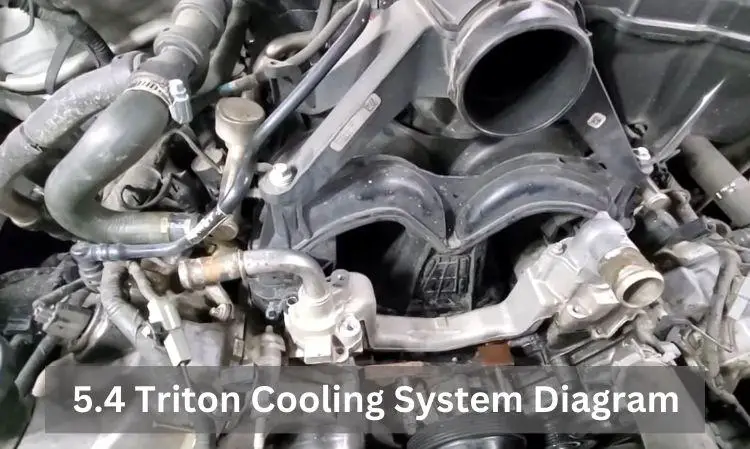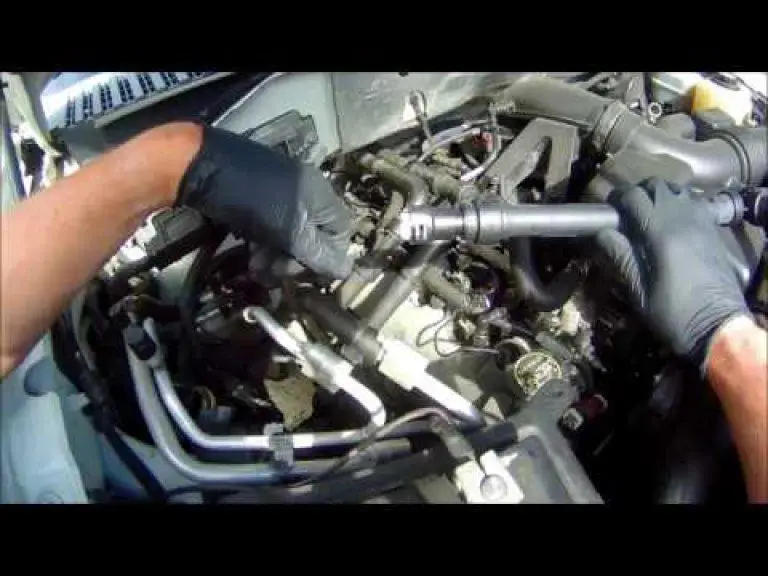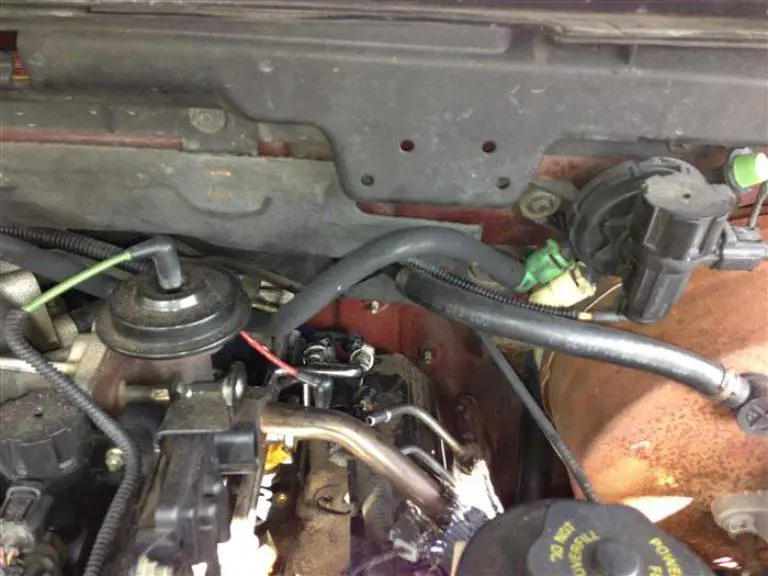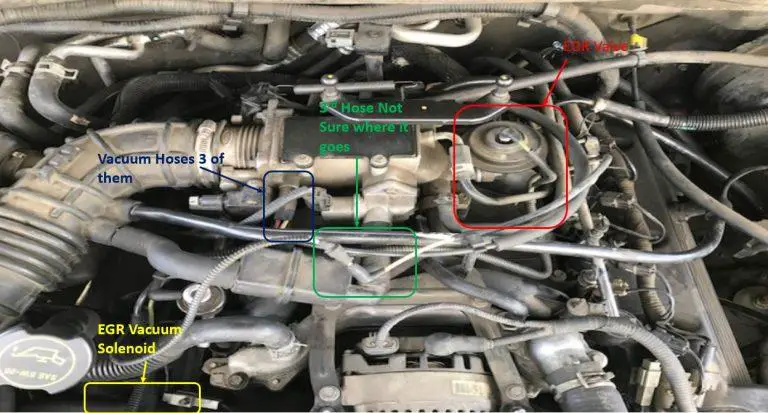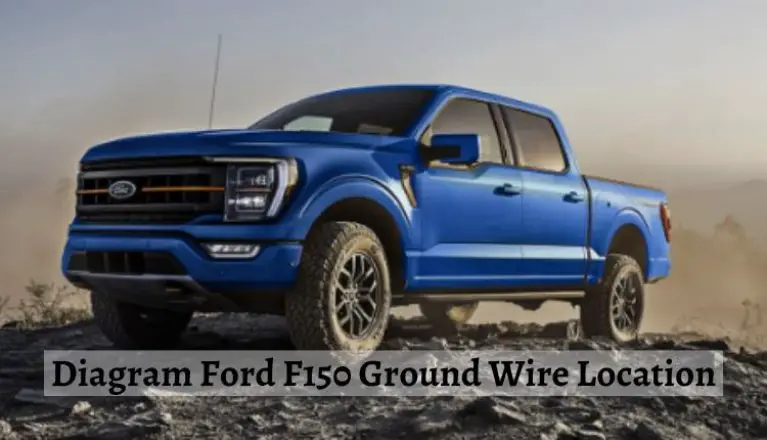5.4 Triton Cooling System Diagram
Last Updated on by David Jon
The 5.4 Triton engine’s cooling system is composed of several parts including the radiator, thermostat, water pump, engine block, hoses, and belts. It helps regulate the engine’s temperature and prevent overheating.
The 5.4 Triton engine is a powerful and efficient engine used in several Ford trucks and SUVs. It is essential to maintain the cooling system of this engine to keep it running smoothly and prevent overheating.
Related Article: Ford F 150 Cooling System Diagram
In this blog post, we will discuss the 5.4 Triton cooling system diagram, its components, working, and maintenance.
Ford 5.4L 3 Valve Coolant Crossover Gaskets, Both Replaced
10 Importance of Cooling System
The cooling system of an engine is one of its most critical components. It regulates the engine’s temperature and prevents overheating, which can cause severe damage to the engine and even cause a complete failure.
A well-maintained cooling system can increase the engine’s efficiency and performance and extend its lifespan.
1. Engine Overheating
An engine is a complex machine that generates a lot of heat during operation, and without proper cooling, the heat can cause serious damage to the engine and even lead to complete failure.
The cooling system plays a critical role in regulating the engine’s temperature and preventing overheating.
2. Engine Efficiency
A properly functioning cooling system helps to maintain the engine’s operating temperature within a specific range, which is crucial for optimal performance and efficiency. If the engine runs too hot or too cold,
It can result in decreased fuel efficiency, increased emissions, and decreased power output.
3. Longevity of the Engine
Excessive heat can cause metal components to expand and deform, leading to leaks and cracks that can severely shorten the lifespan of the engine. A well-maintained cooling system helps to keep the engine running smoothly, and reduces the risk of costly repairs and replacements.
4. Avoiding Costly Repairs
If the cooling system fails, it can lead to severe engine damage, which can be expensive to repair. Regular maintenance, such as flushing the coolant, checking hoses and belts, and replacing the water pump, can help to prevent costly repairs and ensure that the cooling system is functioning optimally.
5. Protecting Other Engine Components
The cooling system helps to protect other engine components, such as the pistons, cylinders, and head gaskets, by preventing overheating. If these components become damaged, they can cause a chain reaction of engine failure, leading to expensive repairs.
6. Improved Driving Experience
A properly functioning cooling system ensures that the engine runs smoothly and efficiently, resulting in a more comfortable and enjoyable driving experience. A well-maintained cooling system also reduces the risk of unexpected breakdowns and the need for costly repairs.
7. Safety on the Road
A failed cooling system can lead to engine failure while driving, which can be a safety hazard. Regular maintenance of the cooling system helps to reduce the risk of engine failure and ensures a safe driving experience.
8. Environmental Impact
A well-maintained cooling system helps to reduce emissions by ensuring that the engine runs efficiently. A failed cooling system can result in increased emissions, which can have a negative impact on the environment.
9. Importance of Regular Maintenance
Regular maintenance of the cooling system, such as flushing the coolant, checking hoses and belts, and replacing the water pump, is crucial for its proper functioning and longevity. Neglecting maintenance can result in a failed cooling system,
Which can cause expensive repairs and decreased engine performance.
10. Understanding the Cooling System Diagram
By understanding the cooling system diagram, you can better understand the components, working, and maintenance of the cooling system. This knowledge can help you to identify potential problems and take proactive steps to prevent costly repairs and engine failure.
The cooling system is a critical component of the engine, and its proper functioning is crucial for the engine’s efficiency, longevity, and performance. Regular maintenance and understanding the cooling system diagram can help to ensure that the cooling system is functioning optimally and prevent expensive repairs and engine failure.
Parts of the 5.4 Triton Cooling System:
Radiator
The radiator is the main component of the cooling system, and its primary function is to transfer heat from the engine to the surrounding air. The radiator is typically made of aluminum and contains a series of thin tubes that carry the coolant.
The coolant is circulated through the engine and the radiator by the water pump, and the air is forced through the radiator by the fan to dissipate the heat.
Water Pump
The water pump is responsible for circulating the coolant through the engine and radiator. The water pump is driven by a belt connected to the engine and contains a series of impellers that move the coolant through the system.
A failed water pump can result in a lack of coolant circulation and overheating of the engine.
Thermostat
The thermostat is a temperature-controlled valve that regulates the flow of coolant through the engine. The thermostat opens when the engine reaches its operating temperature, allowing the coolant to flow through the engine and dissipate heat.
The thermostat then closes, slowing the flow of coolant and preventing overheating.
Hoses
The hoses in the cooling system carry the coolant from the engine to the radiator and back again. The hoses are typically made of rubber and can become brittle and crack over time, leading to leaks in the system.
Regular inspection and replacement of the hoses can prevent leaks and ensure proper coolant circulation.
Radiator Cap
The radiator cap is located on the top of the radiator and is responsible for maintaining the proper pressure in the cooling system. The radiator cap allows the coolant to expand when heated and prevents the coolant from boiling.
A failed radiator cap can result in a loss of pressure in the cooling system and overheating of the engine.
Coolant Reservoir
The coolant reservoir is a container that holds the excess coolant in the system. The coolant reservoir helps to maintain a consistent level of coolant in the system, and can also indicate low coolant levels or leaks in the system.
Fan
The fan is responsible for forcing air through the radiator, dissipating the heat generated by the engine. The fan is typically driven by a belt connected to the engine and is controlled by a thermostatic switch that turns the fan on and off as needed.
Heater Core
The heater core is a small radiator located in the passenger compartment, and its purpose is to heat the interior of the vehicle. The heater core is connected to the engine coolant system, and hot coolant is circulated through the core to provide heat to the interior.
Bypass Hose
The bypass hose is a small hose that circulates coolant around the thermostat, allowing the thermostat to reach its operating temperature more quickly. The bypass hose helps to prevent the engine from overheating during warm-up and ensures that the thermostat functions properly.
Engine Block
The engine block is the main structure of the engine and contains the cylinders, pistons, and other components. The engine block is cooled by the coolant, which circulates through passages within the block to transfer heat to the radiator.
The 5.4 Triton cooling system is comprised of several key components, each of which plays an important role in regulating the engine’s temperature and preventing overheating.
Regular inspection and maintenance of the components, such as the radiator, water pump, thermostat, hoses, and fan, can help to ensure that the cooling system is functioning optimally
See Also:
- 2017 Ford Escape Cooling Fan Relay Location
- Ford Escape Battery Drain Problem
- Top 10 Ford F150 Brake Rotors
Maintenance and Repair of the 5.4 Triton Cooling System
Regular Flushing
Regular flushing of the cooling system is important to remove any buildup of contaminants, such as rust and minerals, that can clog the system and reduce its efficiency. A professional mechanic can perform a coolant flush, which involves draining the coolant from the system and refilling it with fresh coolant.
Replacing Hoses
The hoses in the cooling system are subject to wear and tear and can become brittle and crack over time. Regular inspection and replacement of the hoses can prevent leaks and ensure proper coolant circulation.
A professional mechanic can inspect the hoses for signs of wear and replace them as needed.
Checking the Thermostat
The thermostat is an important component of the cooling system, and a failed thermostat can result in overheating. A professional mechanic can check the thermostat for proper operation and replace it if necessary.
Inspecting the Water Pump
The water pump is responsible for circulating the coolant through the engine and radiator. Regular inspection of the water pump can help to ensure that it is functioning properly and prevent overheating.
A professional mechanic can inspect the water pump for signs of wear or damage, and replace it if necessary.
Replacing the Radiator Cap
The radiator cap is responsible for maintaining the proper pressure in the cooling system. A failed radiator cap can result in a loss of pressure and overheating. A professional mechanic can inspect the radiator cap for proper operation and replace it if necessary.
Inspecting the Fan
The fan is responsible for forcing air through the radiator, dissipating the heat generated by the engine. Regular inspection of the fan can help to ensure that it is functioning properly and prevent overheating. A professional mechanic can inspect the fan for signs of wear or damage, and replace it if necessary.
Checking the Coolant Level
The coolant level in the system should be checked regularly to ensure that it is at the proper level. Low coolant levels can result in overheating, and a professional mechanic can inspect the coolant level and top it off if necessary.
Checking for Leaks
Regular inspection of the cooling system for leaks can help to prevent overheating and reduce the risk of engine damage. A professional mechanic can inspect the system for leaks and repair them as necessary.
Replacing the Radiator
In the event that the radiator becomes damaged or fails, it will need to be replaced. A professional mechanic can remove the old radiator and install a new one to restore the cooling system to proper operation.
Upgrading the Cooling System
In some cases, upgrading the cooling system may be necessary to improve its performance and efficiency. This can involve installing a larger radiator, a high-performance water pump, or a more efficient fan.
A professional mechanic can assess the cooling system and recommend any necessary upgrades.
Regular maintenance and repair of the 5.4 Triton cooling system are essential to ensure its proper operation and prevent overheating. A professional mechanic can perform regular inspections and repairs, and perform any necessary upgrades to improve the performance and efficiency of the system.
10 Common Issues with the 5.4 Triton Cooling System:
1. Leaks
Leaks in the cooling system are one of the most common issues. They can be caused by a variety of factors, including damaged hoses, cracked radiators, or failed water pumps. Leaks can result in low coolant levels, which can cause overheating and engine damage.
2. Clogged Radiator
A clogged radiator can result in reduced cooling efficiency and overheating. The buildup of contaminants, such as rust and minerals, can restrict the flow of coolant through the radiator, causing the engine to overheat.
3. Failed Thermostat
The thermostat is responsible for regulating the flow of coolant through the engine and radiator. A failed thermostat can result in poor circulation of coolant, leading to overheating. A professional mechanic can diagnose and replace a failed thermostat to restore the proper operation of the cooling system.
4. Broken Hoses
Hoses in the cooling system can become brittle and crack over time, causing leaks and reducing the efficiency of the system. A professional mechanic can inspect the hoses for signs of wear and replace them as necessary to prevent leaks and ensure proper circulation of coolant.
5. Failing Water Pump
The water pump is responsible for circulating the coolant through the engine and radiator. A failing water pump can result in poor circulation of coolant, leading to overheating. A professional mechanic can inspect the water pump for signs of wear or damage and replace it if necessary.
6. Damaged Radiator
A damaged radiator can result in leaks and reduced cooling efficiency. A professional mechanic can inspect the radiator for signs of damage, such as cracks or leaks, and replace it if necessary.
7. Clogged Coolant passages
The buildup of contaminants in the coolant passages can restrict the flow of coolant, causing the engine to overheat. A professional mechanic can perform a coolant flush to remove the buildup of contaminants and restore the proper operation of the cooling system.
8. Malfunctioning Fan
The fan is responsible for forcing air through the radiator, dissipating the heat generated by the engine. A malfunctioning fan can result in reduced cooling efficiency and overheating. A professional mechanic can inspect the fan for signs of wear or damage and replace it if necessary.
9. Loose or Broken Drive Belts
Drive belts in the engine can become loose or break, preventing the water pump from functioning properly. A professional mechanic can inspect the drive belts for signs of wear or damage and replace them if necessary to restore the proper operation of the cooling system.
10. Overheating
Overheating is a common issue with the 5.4 Triton cooling system. It can be caused by a variety of factors, including low coolant levels, clogged radiators, failed thermostats, or failing water pumps.
A professional mechanic can diagnose and repair the underlying cause of overheating to restore the proper operation of the cooling system.
The 5.4 Triton cooling system is susceptible to a variety of common issues, including leaks, clogged radiators, failed thermostats, and overheating. A professional mechanic can diagnose and repair these issues to restore the proper operation of the cooling system and prevent engine damage.

FAQs:
What is a 5.4 Triton engine?
The 5.4 Triton engine is a powerful and efficient engine used in several Ford trucks and SUVs.
Why is the cooling system important in a 5.4 Triton engine?
The cooling system regulates the engine’s temperature and prevents overheating, which can cause severe damage to the engine and even cause a complete failure.
What are the components of the 5.4 Triton cooling system?
The components of the 5.4 Triton cooling system include the radiator, thermostat, water pump, engine block, hoses, and belts.
How does the 5.4 Triton cooling system work?
The 5.4 Triton cooling system circulates coolant through the engine and radiator to remove heat from the engine and dissipate it into the air.
Conclusion
The 5.4 Triton cooling system is an essential component of the engine, and its proper functioning is crucial for the engine’s efficiency and performance.
By understanding the diagram of the 5.4 Triton cooling system, its components, working, and maintenance, you can ensure that your engine runs smoothly and prevent overheating.

